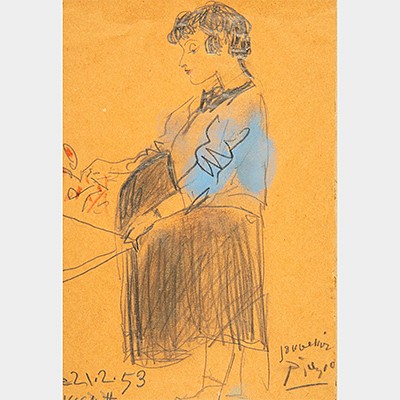ANTONIO SAURA (Huesca, 1930 - Cuenca, 1998). "1984", Original to illustrate the novel by George Orwell, 1983. Mixed media on paper. Reproduced: - Geor
Lot 114
About Seller
Setdart Auction House
Carrer Aragó 346
Barcelona
Spain
Setdart Subastas was born in 2004 and is currently the first online art auction in Spain with solidity, prestige and reliability guaranteed by our more than 60,000 users. Setdart has a young, dynamic and enterprising team ready to successfully manage the purchase and sale of art works through custom...Read more
Categories
Estimate:
EUR€6,000 - EUR€8,000
$6,451.61 - $8,602.15
Absentee vs Live bid
Two ways to bid:
- Leave a max absentee bid and the platform will bid on your behalf up to your maximum bid during the live auction.
- Bid live during the auction and your bids will be submitted real-time to the auctioneer.
Bid Increments
| Price | Bid Increment |
|---|---|
| EUR€0 | EUR€10 |
| EUR€200 | EUR€25 |
| EUR€500 | EUR€50 |
| EUR€1,000 | EUR€100 |
| EUR€3,000 | EUR€200 |
| EUR€5,000 | EUR€500 |
| EUR€10,000 | EUR€1,000 |
| EUR€20,000 | EUR€2,000 |
| EUR€50,000 | EUR€5,000 |
About Auction
By Setdart Auction House
Sep 20, 2021
Set Reminder
2021-09-20 08:00:00
2021-09-20 08:00:00
America/New_York
Bidsquare
Bidsquare : CONTEMPORARY ART
https://www.bidsquare.com/auctions/setdart-auction-house/contemporary-art-7482
Setdart Auction House sofia@setdart.com
Setdart Auction House sofia@setdart.com
- Lot Description
ANTONIO SAURA (Huesca, 1930 - Cuenca, 1998). "1984", Original to illustrate the novel by George Orwell, 1983. Mixed media on paper. Reproduced: - George ORWELL 1984, Georg Éditeur / Genève 2019, French translation by Josée Kamoun,pp.102-103. - George ORWELL Nineteen hundred and eighty-four / 1984, Galaxia Gutenberg / Círculo de Lectores, Barcelona 1998, pp.118-119. Signed and dated in the lower right corner. Size: 30 x 40 cm; 48.5 x 58.5 cm (frame). Antonio Saura was one of the contemporary artists who has fought hardest for a symbiosis between literature and art. Throughout his life he illustrated several books, however, it was 1984, the only one he was unable to see completely finished. In an article in the newspaper El País, written by Elsa Fernández in 1999, the journalist describes the creation of 1984, that "The idea of making 1984 arose from a cover of El País Semanal in January of that year; in it appeared a drawing commissioned from Saura inspired by that book, explains Hans Meinke, who only a few months ago was finally able to see the book published". Self-taught, Antonio Saura began to paint and write in Madrid in 1947. Three years later he held his first individual exhibition in the Libros bookshop in Zaragoza, showing a series of experimental works ("Constelaciones" and "Rayogramas"), produced during the long illness that kept him immobilised for five years from 1943. In 1952 he held his first exhibition in Madrid, at the Buchholz bookshop, where he exhibited his youthful, dreamlike and surrealist works, and in the same year he visited Paris for the first time, settling in the city. There his work was influenced by artists such as Miró and Man Ray, and he began to produce paintings on canvas and paper of an organic nature, using a variety of techniques. The break with the surrealist group allowed him to open up to other creative avenues, where he began to show the evolution of his work, which progressed towards an instantaneous painting with gestural strokes and a reduced palette of a selective nature, where informalism plays at misdirection between suggestive expressions of line and colour. He made his debut in Paris in 1957 at the Stadler gallery, the same year in which he founded the El Paso group. The following year he took part in the Venice Biennale with Chillida and Tàpies, and in 1960 he was awarded the Guggenheim Prize in New York, and in 1963 his first retrospectives were held at the Stedelijk Museum in Eindhoven, the Rotterdamsche Kunstring and the museums of Buenos Aires and Rio de Janeiro (works on paper). Saura's retrospective exhibitions were repeated throughout his career, both in Spain and in Europe and America. In 1966 he exhibited at the Institute of Contemporary Arts in London, and took part in the "Bianco e Nero" Print Biennial in Lugano, winning the Grand Prize. The following year he settled in Paris, although he worked and spent every summer in Cuenca, a fundamental pillar of his production since his early years. In 1968 he abandoned oil painting to devote himself exclusively to works on paper. In 1979 he won a prize at the First Biennial of Engraving in Heidelberg, in 1981 he was named Knight of the Order of Arts and Letters in France, and the following year he was awarded the Gold Medal of Fine Arts. He has exhibited all over the world, and is represented in the most important national and international contemporary art museums, including the Neue National galerie in Berlin, the Guggenheim in Bilbao, the Museo Nacional Centro de Arte Reina Sofía, the Albright-Knox Art Gallery in Buffalo, the Guggenheim, etc.
- Shipping Info
-
In-house shipping available. Please inquire at admin@setdart.com.
-
- Buyer's Premium



 EUR
EUR CAD
CAD AUD
AUD GBP
GBP MXN
MXN HKD
HKD CNY
CNY MYR
MYR SEK
SEK SGD
SGD CHF
CHF THB
THB















